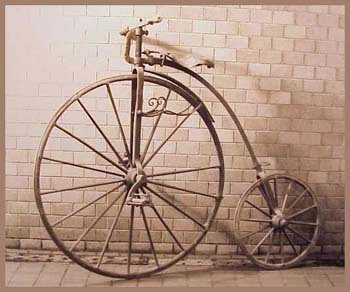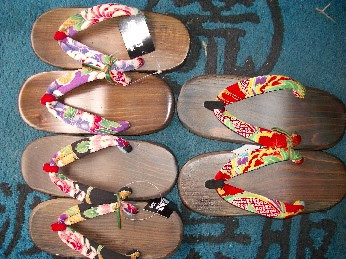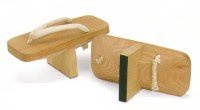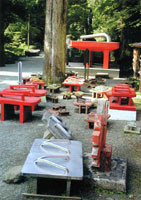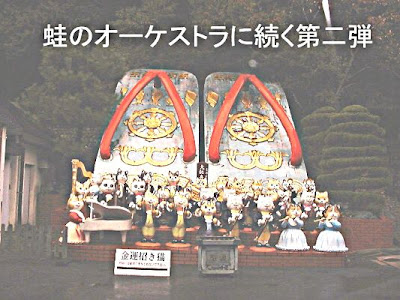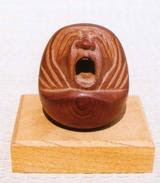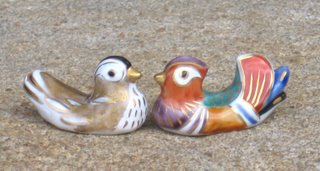:::::::::::::::::::::::::::::::::::::::::::::::::::::::::::::::::::::::::::::::::::::::::::::::::::::
Japanes Musical Instruments
(Part 01)
.. .. .. .. The Drum (ko 鼓)
Daruma san sitting on a drum called Tsutsumi.
(tsuzumi)
First a General Introduction to Japanese Music
From the Virtual Museum of Japanese Arts
The earliest forms of music were drums and flute music accompanying the kagura shrine dances. From the 6th century on, music came from Korean and Chinese courts and monasteries and was performed at the Japanese court under the generic name gagaku (court music). The 8th-century court established a music bureau (gagakuryo) to be in charge of musical duties, both ritual and entertainment. The standard full-range gagaku ensemble has about 16 musicians on percussion, string, and reed instruments, the most distinctive being the free-reed mouth organ (sho), cyndrical oboe (hichiriki), the biwa lute, and the koto zither.
Meanwhile with the introduction of Buddhism to Japan in the 6th century, Buddhist rites and liturgical chants gave rise to the development of a great variety of bells, gongs, wooden clappers, plaques, percussion tubes, and rattles, many of which found their way also into kabuki music of the Edo period (1600-1868).
As Japan changed from a court to a military-dominated culture in the 12th century, theatrical genres of music started to develop. From this time Buddhist evangelists and chanters reciting long historical tales (notably the Heike monogatari) went around the country singing or chanting, accompanying themselves on the biwa lute, while noh became the official entertainment of the new warrior class. Its music was provided by hayashi (an ensemble of drums and flutes) plus chanters.
.. .. .. .. .. Gagaku Ensemble
From the 17th century, the shamisen (three-stringed plucked lute) came to the fore, providing the lively rhythm that dominated the sounds of the popular kabuki and bunraku theaters. In the bunraku puppet theater, a skilled chanter was accompanied by a shamisen, while in kabuki, shamisen solos or choruses were combined with flutes and drums and an eclectic assortment of folk and religious instruments.
Japanese musical instruments are dominated by plucked string, flute and percussion instruments. Among the string instruments, special mention must be made of the koto (13-stringed zither). Formerly part of the gagaku ensemble, the koto was developed as a solo instrument from the 17th century, having its repertoire considerably enhanced by the Ikuta school in the 17th century and the Yamada school in the 18th century. Their solo and chamber music are considered by most Japanese to be the "classical" music of Japan.
In percussion, the taiko nailed drum has taken off in popularity in recent years. Concerts of drum music provide popular entertainment at festivals and events, and drum groups such as Kodo have achieved spectacular success overseas. The end-blown bamboo flute, the shakuhachi, is another noteworthy solo instrument. It first developed under the influence of Zen priests, with new schools of performance growing up from the 16th to 19th centuries.
http://web-japan.org/museum/music/music.html
http://web-japan.org/museum/music/music01/music01.html
:::::::::::::::::::::::::::::::::::::::::::::::::::::::::::::::::::::::::::::::::::::::::::
Now let us look at the Drums used in Buddhist rituals.
I have written about them and other ritual instruments in my book on Buddhist Ritual Implements.
...dietrich-seckel.html
There are a variety of drums and gongs used in Buddhist ritual, we can only look at some of them here.
The Big Drum (taiko, oodaiko 大鼓、太鼓、大太鼓)
http://www5a.biglobe.ne.jp/~suwakou/sub6.htm
Origin: Drums have been used since olden times, maybe first as a means of communication between far away communities. In Buddhism, they are used in rituals and to mark the time. Sometimes the big drum has its own building, the Drum Pavillion (koroo 鼓楼).
Form: The body is like a cylinder, usually made from wood, seldom metal or bamboo. On both sides a piece of leather from an oxen (gyuuhi 牛皮) is streached and kept in place with wide bolts or with a string for smaller drums (shimedaiko 締太鼓). The leather part is hit on one or both sides with a drumstick (bachi バチ). The body of the drum is usually placed on a wooden stand.
. taiko uri 太鼓売り vendor of drums .
in Edo, for the Inari festival
:::::::::::::::::::::::::::::::::::::::::::::::::::::::::::::::::::::::::::::::::::::::::::::::::::::::::::::::::::::::::::

source : facebook
Unusually ornate Ō-daiko (大太鼓)
ca. 1873, attributed to Hayashi Kodenji (林小伝治, 1831–1915)
Metropolitan Museum of Art, New York
:::::::::::::::::::::::::::::::::::::::::::::::::::::::::::::::::::::::::::::::::::::::::::::::::::::::::::::::::::::::::::
Great Decoration-Drum (dadaiko 大太鼓 )
http://www.kousakusha.co.jp/RCMD1/rcmd_1.html
Highly decorated okedo-daiko style drum used for Gagaku and religious ceremonies. The drum is placed in a ornately carved frame, and are played with short, padded beaters. Dadaiko are usually around two meters in diameter, and are one of the oldest styles of taiko used in Japan, dating from at least the 7th century.
There are two styles of Dadaiko, and they are always played in pairs. The Leftside (Saho) Dadaiko and the Rightside (Uho) Dadaiko.
The Saho Dadaiko has green colored body, a futatsu-domoe 二つ巴 is lacquered on the head, and the stand has images of a phoenix surmounted by a sun carved on it.
The Uho Dadaiko had a red colored body, has a mitsu-domoe 三つ巴lacquered on the head, and the stand has Chinese dragons surmounted by a moon carved on it.
http://www.kumidaiko.com/modules.php?name=Encyclopedia&op=content&tid=22
The top of the drum is often decorated with a flaming pattern (kaen daiko 火焔大鼓) . They are placed as a pair on the altar elevation. Around the drum itself there can be another flame decoration (kaenbuchi 火焔縁). On the top decoration (higata 日形)we find a sun (nichirin日輪) on the left and a moon (gachirin月輪) on the left drum.
This drum is about 150 cm long and has a diameter of 127 cm. The great decoration drum of the temple Shin Tennoo-Ji in Oosaka (picture above) has a diameter of 248 cm.
:::::::::::::::::::::::::::::::::::::::::::::::::::::::::::::::::::::::::::::::::::::
Sutra-Drum
(kyoogiri daiko 経切太鼓、kyoodaiko 経太鼓)

This drum is used when reciting the suras to keep the rythm. It is usually very lavishly decorated, a form of the big drum. The wooden body is sometimes also covered with brocade. Even the metal bolts are decorated.
:::::::::::::::::::::::::::::::::::::::::::::::::::::::::::::::::::::::::::::::::::::
Drum for Repentance Ceremonies
(senpoo daiko 懺法太鼓)
http://www.cna.ne.jp/~syazi/estimate/daima/dgeho.htm
This drum is used by many Buddhist sects during special ceremonies of repentance. The sutras are recited with quite a speed and this drum keeps the rythm. The people can remember past sins and repent them while chanting the sutras.
This drum is rather narrow and can be held in one hand. The diameter is usually about 30 - 36 cm. Both sidesare usually covered with religious ornaments in beautiful colors.
Look at this one too:
http://www5e.biglobe.ne.jp/~e-kaori/image/sennpou.8.jpg
::::::::::::::::::::::::::::::::::::::::::::::::::::::::::::::::::::::::::::::::::::::
Drum for reciting Amida prayers
(nenbutsu daiko 念仏太鼓)
http://www.miyamoto-unosuke.co.jp/taiko5.htm
The Amida sects have special chants to pray, Namu Amida Butsu (南無阿弥陀佛), and use this drum to keep the rythm.
It is quite a big one on a shelf and is hit from both sides with sticks. Smaller drums used for prayer dancing ceremonies are held in front of the breast whilst dancing.
::::::::::::::::::::::::::::::::::::::::::::::::::::::::::::::::::::::::::::::::::::::
Drum in form of a Chinese fan
(uchiwadaiko 団扇太鼓)

This drum is used when chanting a special prayer at the Nichiren Sect, the Daimoku 題目. So this drum is also called Daimoku Daiko 題目太鼓. The form resembles a Chinese hand fan, hece the name.
The circular frame is made from wood or bamboo and covered with a piece of leather. The prayer "namu myoohoo rengekyoo", a prayer to the Lotus Sutra, is usually written on the leather. One side has a grip and the drum is beaten with a small wooden stick.
Another form has two sides and a handle in the middle
(ryoomenn etsuki daiko 両面柄付太鼓).

full moon night -
the sound of prayer drums
from the Nichiren temple
. Gabi Greve, October 2011 .
How like the full moon
the white round Nichiren drum
or a hand mirror?
Patrick Duffey
JOJ - Facebook Friend

:::::::::::::::::::::::::::::::::::::::::::::::::::::::::::::::::::::::::::::::
A great site for drums, many illustrations are taken from here:
http://www.suwakougei.com/
http://www.y-m-t.co.jp/wadaiko/okadaya/
Shimedaiko
http://www5a.biglobe.ne.jp/~suwakou/sub7.htm
Drumsticks from various materials, like wood of the cedar (hinoki) , maple (kaede) or oak (kashi).
http://www5a.biglobe.ne.jp/~suwakou/sub8.htm
In Akita, there is The Great Drum Museum (Oodaiko no yakata 『大太鼓の館』) in Takanosu Town and a big Drum Festival. I visited the museum once, it is very impressive with many drums from all over the world. The big ones you see on this picture are played by men sitting on top of it, hitting with long drumsticks.
The museum has many drums which you can play yourself.
http://tonami55.hp.infoseek.co.jp/eki-takanosu.htm
http://www.akita-nairiku.com/intro/01-13.html
http://itp.ne.jp/contents/kankonavi/akita/matsuri/aki_mat12.html
::::::::::::::::::::::::::::::::::::::::::::::::::::::::::::::::::::::::::::::::::::::::::::
.. .. .. .. .. Some useful links
No Play : AYA NO TSUZUMI (THE DAMASK DRUM)
ATTRIBUTED TO SEAMI, BUT PERHAPS EARLIER.
http://www.sacred-texts.com/shi/npj/npj23.htm
History of Percussion Instruments
http://www.taiko-center.co.jp/english/history_of_taiko.html
Asian Drums
http://www.tctv.ne.jp/members/taikokan/tenji_asia.htm
::::::::::::::::::::::::::::::::::::::::::::::::::::::::::::::::::::::::::::::::
The Daruma san on the top picture is sitting on a drum called
tsuzumi (鼓).
This small handheld drum is shaped like an hourglass. The smaller version (kotsuzumi) is held on the right shoulder and the player alters the tone by squeezing the laces. The bigger version (otsuzumi) is held on the left thigh.
Like all other traditional arts in Japan, there are several schools of tsuzumi, which is used for Noo (Noh) and Kabuki performances.
能と歌舞伎につかわれている小鼓、大鼓。
This instrument was introduced from China during the Nara period.
http://www.japan-zone.com/culture/instrument.shtml
:::::::::::::::::::::::::::::::::::::::::::::::::::::::::::::::::::::::::::::::::::::::::::::::::::::

rin 錀 - 鈴 "singing bowl" for prayers and rituals
常に打つ錀なりながら秋の風
tsune ni utsu rin narinagara aki no kaze
the familiar sound
of the singing bowl changed
by autumn wind
Tr. Chris Drake
. WKD : Comment by Chris Drake .
. WKD : Kobayashi Issa 小林一茶 in Edo .
. suzu 鈴 small bell for prayers .
. Himalayan Singing Bowls .
:::::::::::::::::::::::::::::::::::::::::::::::::::::::::::::::::::::::::::::::::::::::::::::::::::::

Mokugyo, the Fish Gong 木魚 and some haiku
. . . . .
. Ondeko 鬼太鼓 (おんでこ) Demon's Drums
The wild drummers from Sado Island and kigo
:::::::::::::::::::::::::::::::::::::::::::::::::::::::::::::::::::::::::::::::::::::::::::::::::::::
H A I K U
kigo for the New Year
uchizome 打初 (うちぞめ) first hitting (the drum)
..... hatsutsuzumi 初鼓(はつつづみ)
..... tsuzumi hajime 鼓始(つづみはじめ)
hatsuookawa 初大鼓(はつおおかわ)"first big leather"
..... hatsudaiko 初太鼓(はつだいこ)first drum
. ponpachi ポンパチ / 初鼓 paper amulet of a drum .
Kagoshima
. SAIJIKI - THE NEW YEAR
.................................................................................
kigo for late spring
. Furukawa no okoshi daiko 古川の起し太鼓
"wake-up drums from Furukawa"
:::::::::::::::::::::::::::::::::::::::::::::::::::::::::::::::::::::::::::::::::::::::::::::::::::::
Rituelle Instrumente Deutscher Text
. . . . . TEXT
Buddhistische Kultgegenstände Japans
:::::::::::::::::::::::::::::::::::::::::::::::::::::::::::::::::::::::::::::::::::::::::::::::::::::
. Biwa 琵琶 lute .
. shooko 鉦鼓 prayer gong .
. Flute (fue) .
yokobue, hichiriki, ryuteki . . .
. Fue 笛 Flute playing Daruma
:::::::::::::::::::::::::::::::::::::::::::::::::::::::::::::::::::::::::::::::::::::::::::::::::::::
. Damaru drum, damru . India and Tibet
. Music and Haiku .
[ . BACK to WORLDKIGO TOP . ]
[ . BACK to DARUMA MUSEUM TOP . ]
:::::::::::::::::::::::::::::::::::::::::::::::::::::::::::::::::::::::::::::::::::::::::::::::::::::
